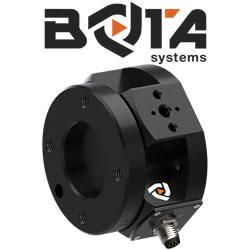Bota Systems’ New SensONE T80 Force-Torque Sensor Optimizes Cobots for Heavy Payloads with Integrated Mounting Flange
The SensONE T80 is equipped with ISO-9409-1-80-6-M8 flanges, directly matching the mounting flanges on the latest UR20 and UR30 cobots from Universal Robots, eliminating the need for an adapter.
Zurich, Switzerland - October 14, 2024 - Bota Systems, a pioneer in multi-axis force-torque sensors, has launched the SensONE T80, specifically designed for larger cobots. Featuring ISO-standard flanges on both sides, the sensor simplifies integration and ensures superior accuracy even with heavier payloads.
The SensONE T80 is equipped with ISO-9409-1-80-6-M8 flanges, directly matching the mounting flanges on the latest UR20 and UR30 cobots from Universal Robots, eliminating the need for an adapter. This streamlines the work of integrators by removing the need for additional engineering to design adapter mounting equipment, significantly reducing time to market. The sensor also includes an ISO 9409-1-50-4-M6 flange to accommodate third-party devices compatible with Universal Robots, facilitating the development of new interfaces.
By removing the need for an adapter, the overall weight of the sensor assembly is minimized, allowing the robot's payload capacity to be fully utilized for material handling rather than merely supporting end-of-arm tooling. Additionally, eliminating adapters reduces the risk of using inappropriate materials that could compromise sensor stiffness and affect measurement accuracy.
A robotic force-torque sensor measures force and torque applied to its surface. Using these real-time measurements in feedback control enables robots to perform complex interaction tasks with precision.
"This sensor, featuring ISO flanges on both sides, is a perfect fit for the UR20 and UR30 models," said Susanne Noerdinger, Head of Ecosystem Success EMEA at Universal Robots. "It provides a high-precision, direct-fit solution that simplifies integration for our customers, enabling them to leverage the full capabilities of our cobots in demanding applications like heavy palletizing and welding. This collaboration with Bota Systems increases the sensitivity and precision of solutions with UR, giving our customers the tools they need to innovate and automate more effectively."
"The SensONE T80 is particularly beneficial for applications such as heavy palletizing and tightening tasks (typically handled by the UR30) and welding (common for the UR20)," said Klajd Lika, CEO & Co-Founder of Bota Systems. "Additional applications include large-scale sanding and polishing, precision mechanical assembly, and face matching/alignment of heavy workpieces, such as in CNC loader operations."
The SensONE T80 can handle up to 80Nm of torque. Its peak-to-peak noise (measured at six times the standard deviation) is 0.3N for force measurements and 0.012Nm for torque, achieving the same precision levels as sensors used for lower payload cobots. Its torque range supports the full payload capacities for cobots exceeding 20kg and 30kg including also the expanded payload of 25kg and 35kg that was recently introduced for UR20 and UR30 respectively.
Bota Systems will showcase the SensONE T80 at the RoboBusiness Conference & Expo in Santa Clara, CA, on October 16-17, alongside its comprehensive range of force-torque sensors. RoboBusiness is the premier event for commercial robotics developers, offering an unparalleled platform for the global robotics community to exchange information, share best practices, and explore new opportunities.
Featured Product

Bota Systems - The SensONE 6-axis force torque sensor for robots
Our Bota Systems force torque sensors, like the SensONE, are designed for collaborative and industrial robots. It enables human machine interaction, provides force, vision and inertia data and offers "plug and work" foll all platforms. The compact design is dustproof and water-resistant. The ISO 9409-1-50-4-M6 mounting flange makes integrating the SensONE sensor with robots extremely easy.
No adapter is needed, only fasteners! The SensONE sensor is a one of its kind product and the best solution for force feedback applications and collaborative robots at its price. The SensONE is available in two communication options and includes software integration with TwinCAT, ROS, LabVIEW and MATLAB®.
